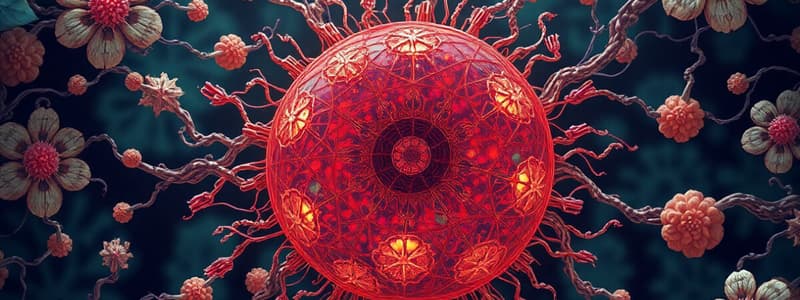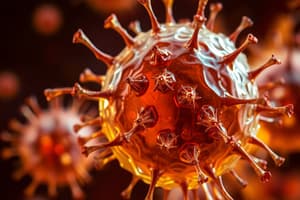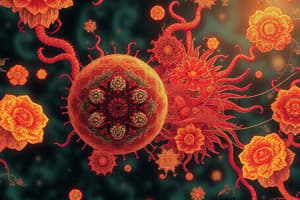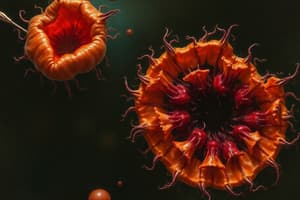Podcast
Questions and Answers
What is the primary function of caspases in apoptosis?
What is the primary function of caspases in apoptosis?
- Stimulating cell growth and division
- Executing programmed cell death (correct)
- Inhibiting cell membrane permeability
- Activating autophagy in stressed cells
Which of the following accurately describes a characteristic of autophagy?
Which of the following accurately describes a characteristic of autophagy?
- Involves the formation of apoptotic bodies
- Engulfs cellular debris or organelles through autophagosomes (correct)
- Leads to swelling and fragmentation of cells
- Directly activates caspases to induce cell death
Which statement best differentiates the intrinsic pathway from the extrinsic pathway of apoptosis?
Which statement best differentiates the intrinsic pathway from the extrinsic pathway of apoptosis?
- Intrinsic pathway is activated by external signals; extrinsic is internal
- Both pathways involve the same mechanism of caspase activation
- Intrinsic pathway is triggered by internal signals; extrinsic is by external signals (correct)
- Intrinsic pathway involves direct caspase activation; extrinsic does not
In which scenario could autophagy lead to cell death?
In which scenario could autophagy lead to cell death?
Which protein class primarily promotes the process of apoptosis?
Which protein class primarily promotes the process of apoptosis?
What distinguishes autophagy from apoptosis in terms of cellular outcomes?
What distinguishes autophagy from apoptosis in terms of cellular outcomes?
Which signaling pathway is NOT typically associated with the regulation of autophagy?
Which signaling pathway is NOT typically associated with the regulation of autophagy?
What is a primary characteristic of the intrinsic pathway of apoptosis?
What is a primary characteristic of the intrinsic pathway of apoptosis?
Which statement accurately describes macroautophagy?
Which statement accurately describes macroautophagy?
What is a significant role of the Bcl-2 protein family in apoptosis?
What is a significant role of the Bcl-2 protein family in apoptosis?
Flashcards are hidden until you start studying
Study Notes
Cell Death Mechanisms
Apoptosis
- Definition: Programmed cell death, a controlled process that leads to the elimination of cells without causing inflammation.
- Characteristics:
- Cell shrinkage and chromatin condensation.
- Formation of membrane-bound apoptotic bodies.
- Phagocytosis of apoptotic cells by neighboring cells or macrophages.
- Pathways:
- Intrinsic Pathway: Triggered by internal signals (e.g., DNA damage, oxidative stress) leading to mitochondrial changes and activation of caspases.
- Extrinsic Pathway: Initiated by external signals (e.g., death ligands binding to receptors) activating caspases directly.
- Caspases: Cysteine proteases that play a central role in executing apoptosis.
- Regulation:
- Pro-apoptotic proteins (e.g., Bax, Bak) promote apoptosis.
- Anti-apoptotic proteins (e.g., Bcl-2, Bcl-xL) inhibit apoptosis.
- Significance: Important for development, immune response, and tissue homeostasis.
Autophagy
- Definition: A cellular degradation process that disassembles unnecessary or dysfunctional components, recycling cellular components.
- Characteristics:
- Formation of autophagosomes that engulf cellular debris or organelles.
- Fusion with lysosomes to degrade contents.
- Can be a survival mechanism under nutrient deprivation or stress.
- Types:
- Macroautophagy: Engulfment of larger cellular structures.
- Microautophagy: Direct invagination of the lysosomal membrane to internalize cytoplasmic material.
- Chaperone-mediated autophagy: Selective degradation of specific proteins via chaperones.
- Regulation:
- Triggered by stress (e.g., starvation, hypoxia).
- Regulated by nutrient-sensing pathways (e.g., mTOR, AMPK).
- Significance: Plays a role in cellular quality control, immunity, and response to stress; can also lead to cell death under certain conditions.
Apoptosis
- Programmed cell death that eliminates cells in a controlled manner, preventing inflammation.
- Characteristic features include cell shrinkage, chromatin condensation, and the formation of apoptotic bodies.
- Apoptotic cells are removed by phagocytosis, primarily by neighboring cells or macrophages.
- Intrinsic Pathway: Activated by internal factors like DNA damage and oxidative stress, leads to mitochondrial changes and caspase activation.
- Extrinsic Pathway: Triggered by external signals, such as death ligands binding to specific receptors, resulting in direct caspase activation.
- Caspases: A family of cysteine proteases critical for executing apoptosis by breaking down cellular components.
- Regulation involves pro-apoptotic proteins (e.g., Bax, Bak) that promote apoptosis, while anti-apoptotic proteins (e.g., Bcl-2, Bcl-xL) inhibit it.
- Essential for various biological processes, including development, immune responses, and maintaining tissue homeostasis.
Autophagy
- A process that degrades and recycles unnecessary or dysfunctional cellular components, contributing to cellular health.
- Autophagosomes are formed to engulf damaged organelles or debris, which then fuse with lysosomes for degradation.
- Functions as a survival mechanism during nutrient deprivation or in response to stress.
- Macroautophagy: Engulfs larger cellular structures for degradation.
- Microautophagy: Involves the invagination of the lysosomal membrane to directly internalize cytoplasmic material.
- Chaperone-mediated autophagy: Selectively degrades specific proteins with the aid of chaperones.
- Autophagy is triggered by stress conditions, including starvation or hypoxia, and is regulated by nutrient-sensing pathways like mTOR and AMPK.
- Plays a significant role in cellular quality control, immune response, and coping with stress; it can also lead to cell death in certain circumstances.
Apoptosis
- Definition: Controlled programmed cell death that prevents inflammation.
- Characteristics:
- Cell shrinkage signifies loss of function.
- Chromatin condensation indicates fragmentation of genetic material.
- Nuclear fragmentation marks the breakdown of the nucleus.
- Membrane blebbing leads to the release of apoptotic bodies.
- Pathways:
- Intrinsic Pathway: Triggered by internal damage, relies on mitochondrial changes and release of cytochrome c.
- Extrinsic Pathway: Initiated by external death signals binding to cell surface receptors.
- Key Proteins:
- Caspases: Protease enzymes that catalyze the apoptosis process.
- Bcl-2 family proteins: Regulate the permeability of the mitochondrial membrane to control apoptosis.
- Significance:
- Essential for maintaining tissue homeostasis by removing unhealthy cells.
- Plays a crucial role in development, tissue remodeling, and immune responses.
Autophagy
- Definition: Catabolic process for the degradation and recycling of cellular components using lysosomes.
- Characteristics:
- Formation of autophagosomes with double membranes encapsulates cellular debris.
- Fusion with lysosomes results in autolysosomes which degrade materials.
- Types:
- Macroautophagy: Involves bulk degradation of cytoplasmic contents for recycling.
- Microautophagy: Direct uptake of cytoplasmic material by lysosomes.
- Chaperone-mediated autophagy: Selective removal of proteins facilitated by chaperones.
- Regulation:
- Activated by stress factors like nutrient deprivation and hypoxia.
- Regulated by signaling pathways such as mTOR and AMPK.
- Significance:
- Crucial for maintaining cellular energy levels and overall homeostasis.
- Plays a protective role against pathogens and cancer.
- Involvement in pathologies related to neurodegenerative conditions and aging processes.
Studying That Suits You
Use AI to generate personalized quizzes and flashcards to suit your learning preferences.





